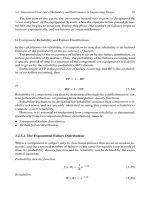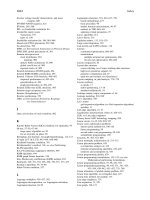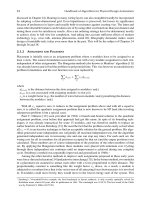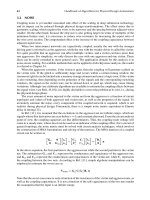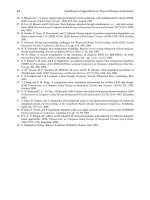Handbook of Materials for Product Design Part 12 ppt
Bạn đang xem bản rút gọn của tài liệu. Xem và tải ngay bản đầy đủ của tài liệu tại đây (2.01 MB, 80 trang )
Coatings and Finishes 9.3
primers. Powder coating material and equipment suppliers worked fe-
verishly to solve the problems associated with automotive topcoats.
Other powder coating applications saw rapid growth. Radiation curable
pigmented coatings for three-dimensional products were developed.
In the 1990s, the decade of compliance, resin and coating suppliers
developed compliance coatings—electrocoating, high-solids, powder,
radiation curable, and waterborne. Equipment suppliers developed de-
vices to apply and cure these new coatings. These developments were
in response to the 1990 amendments to the Clean Air Act of 1970. The
amendments established a national permit program that made the law
more enforceable, ensuring better compliance and calling for nation-
wide regulation of VOC emissions from all organic finishing opera-
tions. The amendments also established
Control Technique Guidelines
to allow state and local governments to develop
Attainment Rules
.
Electrocoating was the process of choice for priming many industrial
and consumer products. Powder coatings were used in a host of appli-
cations where durability was essential. UV curable coatings were ap-
plied to three-dimensional objects. Equipment suppliers developed
more efficient application equipment.
In the 2000s, the beginning of the green millennium, coatings and
equipment suppliers’ investments in research and development will
pay dividends. Improvements in coating materials and application
equipment have enabled end users to comply with air quality regula-
tions. Primers are applied by electrocoating. One-coat finishes are re-
placing two coats in many cases. High-solids and waterborne liquid
coatings are replacing conventional solvent-thinned coatings. Powder
coatings usage has increased dramatically. Radiation-cured coatings
are finding more applications. Coatings and solvent usage, as well as
application costs, are being reduced. Air quality standards are being
met. Coatings and equipment suppliers, as well as end users, are rec-
ognizing the cost savings bonus associated with attainment. Compli-
ance coatings applied by more efficient painting methods will reduce
coatings and solvent usage, thereby effecting cost savings.
Since coatings today are considered to be engineering materials,
their performance characteristics not only must match service re-
quirements, they must also meet governmental regulations and pro-
duction cost considerations. In the past, the selection of a coating
depended mainly on the service requirements and application method.
Now, more than ever before, worker safety, environmental impact, and
economics must be considered. For this reason, compliance coatings-
electrocoating, high-solids, powders, radiation-cured, and waterborne
coatings are the most sensible choices.
Coatings are applied to most industrial products by spraying. Fig-
ure 9.1 shows a typical industrial spray booth. In 1890, Joseph Binks
09Izzo Page 3 Wednesday, May 23, 2001 10:27 AM
9.4 Chapter 9
invented the cold-water paint-spraying machine, the first airless
sprayer, which was used to apply whitewash to barns and other build-
ing interiors. In 1924, Thomas DeVilbiss used a modified medical at-
omizer, the first air-atomizing sprayer, to apply a nitrocellulose
lacquer on the Oakland automobile. Since then, these tools have re-
mained virtually unchanged and, until the enactment of the air qual-
ity standards, they were used to apply coatings at 25 to 50% volume
solids at transfer efficiencies of 30 to 50%. Using this equipment, the
remainder of the nonvolatile material, the overspray, coated the floor
and walls of spray booths and became hazardous or nonhazardous
waste, while the solvents—the VOCs—evaporated from the coating
during application and cure to become air pollutants. Today, finishes
are applied by highly transfer-efficient application equipment. The
choice of application equipment must be optimized.
Even the best coatings will not perform their function if they are not
applied on properly prepared substrates. For this reason surfaces must
first be cleaned to remove oily soils, corrosion products, and particu-
lates, and then pretreated before applying any coatings and finishes.
After coatings are applied, they form films and cure. Curing mecha-
nisms can be as simple as solvent evaporation or as complicated as
free-radical polymerization. Basically, coatings can be classified as
Figure 9.1 A typical industrial spray booth used for applying industrial coatings. (Cour-
tesy of George Koch Sons, LLC.)
09Izzo Page 4 Wednesday, May 23, 2001 10:27 AM
Coatings and Finishes 9.5
baking
or
air drying,
which usually means room-temperature curing.
The curing method and times are important in coating selection, be-
cause they must be considered for optimizing equipment and produc-
tion schedules choices.
The purposes of this chapter are threefold: (1) to aid the designer in
optimizing the selection of coating materials and application equip-
ment; (2) to acquaint the reader with surface preparation, coating ma-
terials, application equipment, and curing methods; and (3) to stress
the importance of environmental compliance in coating operations.
9.2 Environment and Safety
In the past, changes in coating materials and coating application lines
were discussed only when lower prices, novel products, new coating
lines, or new plants were considered. Today, with rising material
costs, rising energy costs, and more restrictive governmental regula-
tions, they are the subject of frequent discussions. During these dis-
cussions, both in-house and with suppliers, choices of coating
materials and processing equipment are optimized. Coating material
and solvent costs, which are tied to the price of crude oil, have risen
since the 1970s, as has the cost of natural gas, which is the most fre-
quently used fuel for coating bake ovens. The EPA has imposed re-
strictive air quality standards. The Occupational Safety and Health
Act (OSHA) and the Toxic Substances Control Act (TSCA) regulate
the environment in the workplace and limit workers’ contact with
hazardous materials. These factors have increased coating costs and
the awareness of product finishers. To meet the challenge, they must
investigate and use alternative coating materials and processes for
compliance and cost effectiveness.
Initial attempts to control air pollution in the late 1940s resulted in
smoke-control laws to reduce airborne particulates. The increased use
of the automobile and industrial expansion during that period caused
a condition called
photochemical smog
(smog created by the reaction of
chemicals exposed to sunlight in the atmosphere) in major cities
throughout the United States. Los Angeles County officials recognized
that automobile exhaust and VOC emissions were major sources of
smog, and they enacted an air pollution regulation called Rule 66.
Rule 66 forbade the use of specific solvents that produced photochemi-
cal smog and published a list of exempt solvents for use in coatings.
Further study by the EPA has shown that, if given enough time, even
the Rule 66 exempt solvents will produce photochemical smog in the
atmosphere.
The Clean Air Act of 1970, and its 1990 amendments, formulated
by the EPA, established national air quality standards that regulate
09Izzo Page 5 Wednesday, May 23, 2001 10:27 AM
9.6 Chapter 9
the amount of solvents emitted. The EPA divided the 50 states into
250 air quality regions, each of which is responsible for the imple-
mentation of the national air quality standards. It is important to
recognize that many of the local standards are more stringent than
the national ones. For this reason, specific coatings that comply with
the air quality standards of one district may not comply with an-
other’s. Waterborne, high-solids, powder, electrophoretic, and radia-
tion-cured coatings will comply. The use of precoated metal can
eliminate all the compliance problems.
Not only because the EPA mandates the reduction of VOC emis-
sions, but also because of economic advantages, spray painting, which
is the most used application method, must be done more efficiently.
The increased efficiency will reduce the amount of expensive coatings
and solvents used, thereby reducing production costs.
9.3 Surface Preparation
The most important step in any coating operation is surface prepara-
tion, which includes cleaning and pretreatment. For coatings to ad-
here, surfaces must be free from oily soils, corrosion products, and
loose particulates. New wood surfaces are often coated without clean-
ing. Old wood and coated wood must be cleaned to remove oily soils
and loose, flaky coatings. Plastics are cleaned by using solvents and
chemicals to remove mold release. Metals are cleaned by media blast-
ing, sanding, brushing, and by solvents or aqueous chemicals. The
choice of a cleaning method depends on the substrate and the size and
shape of the object.
After cleaning, pretreatments are applied to enhance coating adhe-
sion and, in the case of metals, corrosion resistance. Some wood sur-
faces require no pretreatment, while others require priming of knots
and filling of nail holes. Cementitious and masonry substrates are pre-
treated using acids to remove loosely adhering contaminants and to
passivate the surfaces. Metals, still the most common industrial sub-
strates, are generally pretreated using phosphates, chromates, and
oxides to passivate their surfaces and provide corrosion resistance.
Plastics, second only to steel, are gaining rapidly in use as industrial
substrates. Some are paintable after cleaning to remove mold release
and other contaminants, while others require priming, physical treat-
ments, or chemical etching to ensure coating adhesion. Since most of
the industrial substrates coated are metals and plastics, their clean-
ing and pretreatment are described in the next sections. Because of
their complexities, detailed descriptions of cleaning and pretreatment
processes are beyond the scope of this chapter. Enough detail will be
given to allow the reader to make a choice. As with the choice of a
09Izzo Page 6 Wednesday, May 23, 2001 10:27 AM
Coatings and Finishes 9.7
cleaning method, the choice of a pretreatment method depends on the
composition, size, and shape of the product.
9.3.1 Metal Surface Cleaning
Oily soils must be removed before any other surface preparation is at-
tempted. Otherwise these soils may be spread over the surface. These
soils can also contaminate abrasive cleaning media and tools. Oily
soils can be removed faster using liquid cleaners that impinge on the
surface or in agitated immersion baths. It is often necessary to heat
liquid cleaners to facilitate soil removal.
9.3.1.1 Abrasive cleaning.
After removal of the oily soils, surfaces are
abrasive cleaned to remove rust and corrosion by media blasting, hand
or power sanding, and hand or power brushing. Media blasting con-
sists of propelling materials, such as sand, metallic shot, nut shells,
plastic pellets, and dry ice crystals, by gases under pressure, so that
they impinge on the surfaces to be cleaned. High-pressure water-jet
cleaning is similar to media blasting.
9.3.1.2 Alkaline cleaning.
To remove oily soils, aqueous solutions of al-
kaline phosphates, borates, and hydroxides are applied to metals by
immersion or spray. After cleaning, the surfaces are rinsed with clear
water to remove the alkali. These materials are not effective for re-
moving rust and corrosion.
9.3.1.3 Detergent cleaning.
Aqueous solutions of detergents are used
to remove oily soils in much the same way as alkaline cleaners. Then
they are rinsed with cold water to flush away the soils.
9.3.1.4 Emulsion cleaning.
Heavy oily soils and greases are removed
by aqueous emulsions of organic solvents such as mineral spirits and
kerosene. After the emulsified solvent has dissolved the oily soils, they
are flushed away using a hot-water rinse. Any remaining oily residue
must be removed using clean solvent, alkaline, or detergent cleaners.
9.3.1.5 Solvent cleaning.
Immersion, hand wiping, and spraying us-
ing organic solvents are effective methods for removing oily soils.
Since these soils will contaminate solvents and wipers, it is important
to change them frequently. Otherwise, oily residues will remain on
substrates. Safe handling practices must be followed because of the
hazardous nature of most organic solvents.
09Izzo Page 7 Wednesday, May 23, 2001 10:27 AM
9.8 Chapter 9
9.3.1.6 Manual spray cleaning.
For large products, detergent and al-
kaline cleaners applied using steam cleaners are a well-known de-
greasing method. In addition to oily soils, the impingement of the
steam and the action of the chemicals will dissolve and flush away
heavy greases and waxes. Hot-water spray cleaning using chemicals is
nearly as effective as steam cleaning.
9.3.1.7 Vapor degreasing.
Vapor degreasing has been a very popular
cleaning method for removing oily soils. Boiling solvent condenses on
the cool surface of the product and flushes away oily soils, but does not
remove particulates. Since this process uses chlorinated solvents,
which are under regulatory scrutiny by government agencies, its pop-
ularity is declining. However closed-loop systems are still available.
9.3.2 Metal Surface Pretreatment
Cleaning metals will remove oily soils but generally will not remove
rust and corrosion from substrates to be coated. Abrasive cleaning will
remove corrosion products, and for this reason it is also considered a
pretreatment, because the impingement of blasting media and the ac-
tion of abrasive pads and brushes roughen the substrate and therefore
enhance adhesion. The other pretreatments use aqueous chemical so-
lutions, which are applied by immersion or spray techniques. Pre-
treatments for metallic substrates used on industrial products are
discussed in this section. Because they provide corrosion protection to
ferrous and nonferrous metals, chromates are used in pretreatment
stages and as conversion coatings. They are being replaced by non-
chromate chemicals.
9.3.2.1 Aluminum.
Aluminum is cleaned by solvents and chemical so-
lutions to remove oily soils and corrosion products. Cleaned aluminum
is pretreated using chromate conversion coating and anodizing. Phos-
phoric acid-activated vinyl wash primers, which are also considered
pretreatments, must be applied directly to metal and not over other
pretreatments.
9.3.2.2 Copper.
Copper is cleaned by solvents and chemicals and
then abraded to remove corrosion. Bright dipping in acids will also re-
move corrosion. Cleaned surfaces are often pretreated using chro-
mates and vinyl wash primers.
9.3.2.3 Galvanized steel.
Galvanized steel must be cleaned to remove
the oil or wax that is applied at the mill to prevent white corrosion. Af-
09Izzo Page 8 Wednesday, May 23, 2001 10:27 AM
Coatings and Finishes 9.9
ter cleaning, the surfaces are pretreated using chromates and phos-
phates. Vinyl wash primer pretreatments can also be applied on
galvanized steel surfaces having no other pretreatments.
9.3.2.4 Steel.
Steel surfaces are cleaned to remove oily soils and, if
necessary, pickled in acid to remove rust. Clean steel is generally pre-
treated with phosphates to provide corrosion resistance. Other pre-
treatments for steel are chromates and wash primers.
9.3.2.5 Stainless steel.
Owing to its corrosion resistance, stainless
steel usually is not coated. Otherwise, the substrate must be cleaned
to remove oily soils and then abraded to roughen the surface. Wash
primers will enhance adhesion.
9.3.2.6 Titanium.
Cleaned titanium is pretreated like stainless steel.
9.3.2.7 Zinc and cadmium.
Zinc and cadmium substrates are pre-
treated like galvanized steel.
9.3.3 Plastic Surface Cleaning
9.3.3.1 Alkaline cleaning.
Aqueous solutions of alkaline phosphates,
borates, and hydroxides are applied to plastics by immersion or spray
to remove oily soils and mold release agents. After cleaning, the sur-
faces are rinsed with clear water to remove the alkali.
9.3.3.2 Detergent cleaning.
Aqueous solutions of detergents are used
to remove oily soils and mold release agents in much the same way as
with alkaline cleaners. Then they are rinsed with cold water to flush
away the soils.
9.3.3.3 Emulsion cleaning.
Heavy, oily soils, greases, and mold release
agents are removed by aqueous emulsions of organic solvents such as
mineral spirits and kerosene. After the emulsified solvent has dis-
solved the oily soils, they are flushed away using a hot-water rinse.
The remaining oily residue must be removed using clean solvent, alka-
line, or detergent cleaners.
9.3.3.4 Solvent cleaning.
Immersion, hand wiping, and spraying, us-
ing organic solvents, are effective methods for removing oily soils and
09Izzo Page 9 Wednesday, May 23, 2001 10:27 AM
9.10 Chapter 9
mold release agents. Since these soils will contaminate solvents and
wipers, it is important to change them frequently. Otherwise, oily res-
idues will remain on substrates. Compatibility of cleaning solvents
with the plastic substrates is extremely important. Solvents that af-
fect plastics are shown in Table 9.1. Suppliers of mold release agents
are the best source for information on solvents that will remove their
materials. Safe handling practices must be followed because of the
hazardous nature of most organic solvents.
9.3.3.5 Manual spray cleaning.
Detergent and alkaline cleaners ap-
plied using steam and hot-water spray cleaners are a well known de-
greasing method. The method can also be used for removing mold
release agents. The impingement of the steam and hot water and the
action of the chemicals will dissolve and flush away the contaminants.
Manual spray cleaning is used for large products.
9.3.4 Plastic Surface Pretreatment
Cleaning will remove oily soils and mold release agents, but additional
pretreatment may be needed on certain plastic surfaces to ensure ad-
hesion. Many of the plastic substrates are chemically inert and will not
accept coatings because of their poor wettability. Depending on their
09Izzo Page 10 Wednesday, May 23, 2001 10:27 AM
Coatings and Finishes 9.11
chemical composition, they will require mechanical, chemical, and
physical pretreatment or priming to enhance coating adhesion. Since
mechanical pretreatment consists of abrasion, its effect on the sub-
strate must be considered. Chemical pretreatments involve corrosive
materials that etch the substrates and can be hazardous. Therefore,
handling and disposal must be considered. Physical pretreatments
consist of plasma, corona discharge, and flame impingement. Process
control must be considered.
9.3.4.1 Abrasive cleaning.
After removal of the oily soils, surfaces are
abrasive pretreated to roughen the substrate by media blasting, hand
or power sanding, and hand or power brushing. Media blasting con-
sists of propelling materials such as sand, metallic shot, nut shells,
plastic pellets, and dry ice crystals by gases under pressure so that
they impinge on the surfaces to be pretreated.
9.3.4.2 Chemical etching.
Chemical pretreatments use solutions of
corrosive chemicals, which are applied by immersion or spray tech-
niques, to etch the substrate.
9.3.4.3 Corona discharge.
During corona discharge pretreatment, the
plastic is bombarded by gases directed toward its surface.
9.3.4.4 Flame treating.
During the flame pretreatment, an open flame
impinging on the surface of the plastic product causes alterations in
the surface chemistry.
9.3.4.5 Plasma pretreatment.
Low-pressure plasma pretreatment is
conducted in a chamber, while atmospheric plasma pretreatment is
done in the open. In both cases, ablation alters the surface chemistry
and causes changes in surface roughness.
9.3.4.6 Laser pretreatment.
Laser pretreatment ablates the plastic
substrate causing increased surface roughness and changes in the sur-
face chemistry.
9.3.5 Priming
Priming involves the application of a coating on the surface of the
plastic product to promote adhesion or to prevent attack by the sol-
09Izzo Page 11 Wednesday, May 23, 2001 10:27 AM
9.12 Chapter 9
vents in a subsequent protective or decorative coating. In some cases,
priming can be done after cleaning. In others, it must be done after
pretreatment.
9.4 Coating Selection
To aid in their selection, coatings will be classified by their use in fin-
ish systems, physical state, and resin type. Coatings are also classified
by their use as electrical insulation. It is not the intent of this chapter
to instruct the reader in the chemistry of organic coating but rather to
aid in selection of coatings for specific applications. Therefore, the
coating resin’s raw material feed stock and polymerization reactions
will not be discussed. On the other hand, generic resin types, curing,
physical states, and application methods are discussed.
9.4.1 Selection by Finish Systems
Finish systems can be one-coat or multicoat schemes that use primers,
intermediate coats, and topcoats. Primers provide adhesion, corrosion
protection, passivation, and solvent resistance to substrates. Topcoats
provide weather, chemical, and physical resistance and generally de-
termine the performance characteristics of finish systems. Perfor-
mance properties for coatings, formulated with the most commonly
used resins, are shown in Table 9.2.
In coating selection, intended service conditions must be considered.
To illustrate this point, consider the differences between service condi-
tions for toy boats and for battleships. Table 9.3 shows the use of in-
dustrial finish systems in various service conditions.
9.4.2 Selection by Physical State
A resin’s physical state can help determine the application equipment
required. Solid materials can be applied by powder coating methods.
09Izzo Page 12 Wednesday, May 23, 2001 10:27 AM
Coatings and Finishes 9.13
Table 9.4 lists resins applied as powder coatings. Liquids can be ap-
plied by most of the other methods, which are discussed later. Many of
the coating resins exist in several physical states. Table 9.5 lists the
physical states of common coating resins.
9.4.3 Selection by Resin Type
Since resin type determines the performance properties of a coating,
it is used most often. Table 9.6 shows the physical, environmental,
and film-forming characteristics of coatings by polymer (resin) type. It
09Izzo Page 13 Wednesday, May 23, 2001 10:27 AM
9.14
09Izzo Page 14 Wednesday, May 23, 2001 10:27 AM
9.15
09Izzo Page 15 Wednesday, May 23, 2001 10:27 AM
9.16
09Izzo Page 16 Wednesday, May 23, 2001 10:27 AM
9.17
09Izzo Page 17 Wednesday, May 23, 2001 10:27 AM
9.18 Chapter 9
is important to realize that in, selecting coatings, tables of perfor-
mance properties of generic resins must be used only as guides, be-
cause coatings of one generic type, such as acrylic, epoxy, or
polyurethane, are often modified using one or more of the other ge-
neric types. Notable examples are acrylic alkyds, acrylic urethanes,
acrylic melamines, epoxy esters, epoxy polyamides, silicone alkyds,
silicone epoxies, silicone polyesters, vinyl acrylics, and vinyl alkyds.
While predicting specific coating performance properties of unmodi-
fied resins is simple, predicting the properties of modified resins is dif-
ficult, if not impossible. Parameters causing these difficulties are
resin modification percentages and modifying methods such as simple
blending or copolymerization. The performance of a 30% copolymer-
ized silicone alkyd is not necessarily the same as one which was mod-
ified by blending. These modifications can change the performance
properties subtly or dramatically.
3
There are more than 1200 coating manufacturers in the United
States, each having various formulations that could number in the
hundreds. Further complicating the coatings selection difficulty is the
well known practice of a few coating manufacturers who add small
amounts of a more expensive, better performing resin to a less expen-
sive, poorer performing resin and call the product by the name of the
former. An unsuspecting person, whose choice of such a coating is
based on properties of the generic resin, can be greatly disappointed.
Instead, selections must be made on the basis of performance data for
specific coatings or finish systems. Performance data are generated by
the paint and product manufacturing industries when conducting
standard paint evaluation tests. Test methods for coating material
evaluation are listed in Table 9.7.
9.4.4 Selection by Electrical Properties
Electrical properties of organic coatings vary by resin (also referred to
as
polymer
) type. When selecting insulating varnishes, insulating
enamels, and magnet wire enamels, the electrical properties and
physical properties determine the choice.
Table 9.8 shows electric strengths, Table 9.9 shows volume resistivi-
ties, Table 9.10 shows dielectric constants, and Table 9.11 shows dissi-
pation factors for coatings using most of the available resins. Magnet
wire insulation is an important use for organic coatings. National Elec-
trical Manufacturer’s Association (NEMA) standards and manufactur-
ers’ trade names for various wire enamels are shown in Table 9.12. This
information can be used as a guide in the selection of coatings. How-
ever, it is important to remember the aforementioned warnings about
blends of various resins and the effects on performance properties.
09Izzo Page 18 Wednesday, May 23, 2001 10:27 AM
9.19
TABLE
9.7 Specific Test Methods for Coatings
*
Test ASTM
Federal Std.
141a, method
MIL-Std
202, method
Federal Std.
406, method Others
Abrasion D968 6191 (Falling sand)
6192 (Taber)
1091 Fed. Std. 601, 14111
Adhesion D2197 6301.1 (Tape test, wet)
6302.1 (Microknife)
6303.1 (Scratch adhesion)
6304.1 (Knife test)
1111 Fed. Std. 601, 8031
Arc resistance D495 303 4011
Dielectric constant D150 301 4021 Fed. Std. 101, 303
Dielectric strength
(breakdown voltage)
D149
D115
4031 Fed. Std. 601, 13311
Dissipation factor D150 4021
Drying time D1640
D115
4061.1
Electrical insulation
resistance
D229
D257
302 4041 MIL-W-81044, 4.7.5.2
Exposure (interior) D1014 6160 (On metals)
6161.1 (Outdoor rack)
Flash point D56, D92
D1310 (Tag open cup)
4291 (Tag Closed Cup)
4294 (Cleveland Open Cup)
Fed. Std. 810, 509
Flexibility 6221 (Mandrel)
6222 (Conical Mandrel)
1031 Fed. Std. 601, 11041
Fungus resistance D1924 MIL-E-5272, 4.8
MIL-STD-810, 508.1
MIL-T-5422, 4.8
Hardness D1474 6211 (Print Hardness)
6212 (Indentation)
Heat resistance D115
D1932
6051
Humidity D2247 6071 (100% RH)
6201 (Continuous Condensation)
103
106A
MIL-E-5272, proc. 1
Fed. Std. 810, 507
09Izzo Page 19 Wednesday, May 23, 2001 10:27 AM
9.20
Impact resistance 6226 (G.E. Impact) 1074
Moisture-vapor
permeability
E 96
D1653
6171 7032
Nonvolatile content 4044
Salt spray (fog) B117 6061 101C 6071 MIL-STD-810, 509.1
MIL-E-5272, 4.6
Fed. Std. 151, 811.1
Fed. Std. 810, 509
Temperature-altitude MIL-E-5272, 4.14
MIL-T-5422, 4.1
MIL-STD-810, 504.1
Thermal conductivity D1674 (Cenco Fitch)
C177 (Guarded hot plate)
MIL-I-16923, 4.6.9
Thermal shock 107 MIL-E-5272, 4.3
MIL-STD-810,503.1
Thickness (dry film) D1005
D1186
6181 (Magnetic Gage)
6183 (Mechanical Gage)
2111, 2121, 2131, 2141,
2151
Fed. Std. 151, 520, 521.1
Viscosity D1545
D562
D1200
D88
4271 (Gardner Tubes)
4281 (Krebs-Stormer)
4282 (Ford Cup)
4285 (Saybolt)
4287 (Brookfield)
Weathering (accelerated) D822 6151 (Open Arc)
6152 (Enclosed Arc)
6024
*
Note: A more complete compilation of test methods is found in J.J. Licari,
Plastic Coatings for Electronics,
McGraw-Hill, New York, 1970. The major collection of
complete test methods for coatings is
Physical and Chemical Examination of Paints, Varnishes, Lacquers, and Colors,
by Gardner and Sward, Gardner Laboratory,
Bethesda, MD. This has gone through many editions.
TABLE
9.7 Specific Test Methods for Coatings
*
(Continued)
Test ASTM
Federal Std.
141a, method
MIL-Std
202, method
Federal Std.
406, method Others
09Izzo Page 20 Wednesday, May 23, 2001 10:27 AM
Coatings and Finishes 9.21
09Izzo Page 21 Wednesday, May 23, 2001 10:27 AM
9.22 Chapter 9
9.5 Coating Materials
Since it is the resin in the coating’s vehicle that determines its perfor-
mance properties, coatings can be classified by their resin types. The
most widely used resins for manufacturing modern coatings are acryl-
ics, alkyds, epoxies, polyesters, polyurethanes, and vinyls.
3
In the fol-
lowing section, the resins used in coatings are described.
9.5.1 Common Coating Resins
9.5.1.1 Acrylics.
Acrylics are noted for color and gloss retention in
outdoor exposure. Acrylics are supplied as solvent-containing, high-
solids, waterborne, and powder coatings. They are formulated as lac-
quers, enamels, and emulsions. Lacquers and baking enamels are
used as automotive and appliance finishes. Both these industries use
acrylics as topcoats for multicoat finish systems. Thermosetting acryl-
ics have replaced alkyds in applications requiring greater mar resis-
tance, such as appliance finishes. Acrylic lacquers are brittle and
therefore have poor impact resistance, but their outstanding weather
resistance allowed them to replace nitrocellulose lacquers in automo-
tive finishes for many years. Acrylic and modified acrylic emulsions
have been used as architectural coatings and also on industrial prod-
ucts. These medium-priced resins can be formulated to have excellent
hardness, adhesion, abrasion, chemical, and mar resistance. When
acrylic resins are used to modify other resins, their properties are of-
ten imparted to the resultant resin system.
Uses.
Acrylics, both lacquers and enamels, were the topcoats of choice
for the automotive industry from the early 1960s to the middle 1980s.
09Izzo Page 22 Wednesday, May 23, 2001 10:27 AM
Coatings and Finishes 9.23
09Izzo Page 23 Wednesday, May 23, 2001 10:27 AM
9.24 Chapter 9
09Izzo Page 24 Wednesday, May 23, 2001 10:27 AM
Coatings and Finishes 9.25
09Izzo Page 25 Wednesday, May 23, 2001 10:27 AM
9.26
09Izzo Page 26 Wednesday, May 23, 2001 10:27 AM
9.27
09Izzo Page 27 Wednesday, May 23, 2001 10:27 AM
